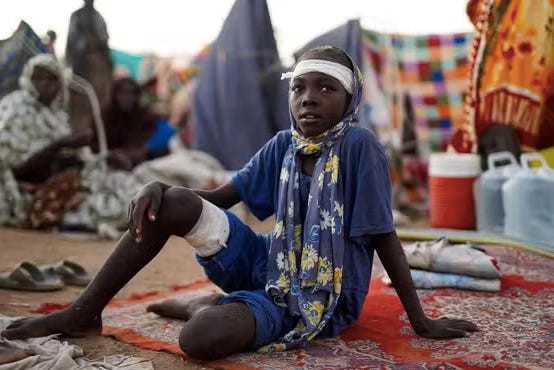After Libya
Moscow is fanning flames of conflict in Africa
(A boy in a camp for displaced people who fled El-Fasher for Tawila, in northern Darfur, Sudan, on October 27th, 2025. [Mohammed Jamal / Reuters])
After toppling Gaddafi in 2011, allies left Libya in flux, with no serious plan for stable governance. This power vacuum became a foreign interference free-for-all. Two civil wars in Libya fed larger conflicts in South Sudan, Mali, Ethiopia, Sudan.
Up to 2005, Sudan had faced protracted civil wars. After an elaborate UN-led exercise, the new state of South Sudan was proclaimed in 2011. By 2013, president Kiir and vice president Machar were at daggers drawn in Juba. Kiir had backing from Uganda, China, Egypt, Israel and the Gulf. Machar relied on Sudan, Ethiopia and Kenya. South Sudan’s civil war saw 400,000 killed, four million displaced.
In Mali, a Tuareg rebellion in 2012 revived jihadist insurgency. Starting in 2013, France deployed Operations Serval and Barkhane. But a Russia-backed 2020 coup overthrew Mali’s legitimate government and a 2021 ‘coup within a coup’ deepened the chaos. France withdrew in 2022. Mali, a stable, multiparty democracy from 1991 to 2012, is now a hotbed of militant warlordism.
Islamist insurgencies devastated the Sahel from Mali to the Lake Chad Basin. By 2015-16, four million were displaced in Chad, Nigeria, Niger and Cameroon. Jihadists trained in Afghanistan and Syria are now targeting Somalia.
As allies disengaged, Russia deployed Wagner mercenaries in 2017-18 to protect their proxy Haftar in Libya and coup plotters in Central African Republic, who put down new coup challenges in 2020-21. Moscow then aided juntas behind two successful coups in Burkina Faso in 2022 and another in Niger in 2023.
To bolster this military leverage, Moscow rekindled military ties with Ethiopia in 2018. When the Tigray People’s Liberation Front (TPLF) attacked in 2020, Russia backed Addis Ababa, leaving 500,000 dead and five million displaced.
Since Sudan had supported the TPLF, Russia used bases in Libya to arm Sudan’s enemy, the Rapid Support Forces (RSF), which have fought Khartoum since 2023, leaving hundreds of thousands dead and twelve million displaced.
Libya, Mali, Ethiopia, Burkina Faso, Niger, Sudan: Russia has had a leading hand in each of these conflicts and coups. Africa’s new wars – alongside Syria, Ukraine and Venezuela, where Russia is also the aggressor – have doubled the number of displaced worldwide to well over 120 million.
Democracies have yet to mount any concerted response. In Libya, Haftar’s military sponsors are Russia, Egypt and UAE, while Turkey, Qatar and Italy back the UN-backed regime in Tripoli. As incoherence reigns, the responsibility to protect — which took us to Libya in 2011 — is a dead letter.
This vortex of violence is exacting a massive human toll: child soldiers killed, families ruined, livelihoods destroyed. It must be laid mostly at Moscow’s door. Allied inaction has only made matters worse. Without renewed strategic purpose, the number and scale of conflicts in Africa and beyond will only grow.



